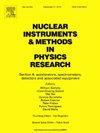RPC探测器中hfo基混合气体的信号形态研究及速率依赖性
IF 1.4
3区 物理与天体物理
Q3 INSTRUMENTS & INSTRUMENTATION
Nuclear Instruments & Methods in Physics Research Section A-accelerators Spectrometers Detectors and Associated Equipment
Pub Date : 2025-06-28
DOI:10.1016/j.nima.2025.170770
引用次数: 0
摘要
目前,大型强子对撞机实验中使用的RPCs在雪崩模式下运行,混合物中含有大量C2H2F4(≈90%或更多),并添加不同浓度的i-C4H10和SF6。然而,C2H2F4和SF6是氟化温室气体(f -gas),其全球变暖潜能值(GWP)分别为≈1400和≈22 800。欧盟法规要求逐步减少C2H2F4的生产和消费,旨在大力减少其排放。这已经导致其价格上涨和供应减少。这个问题最理想的长期解决方案是找到一种替代的,无f气体的气体混合物,能够保持类似的探测器性能。为了研究用于RPC探测器的低GWP气体混合物,RPC ECOGasas@GIF++合作(包括ALICE、ATLAS、CMS、SHiP/LHCb和CERN EP-DT组的RPC专家)于2019年成立,目前正在研究一种来自烯烃家族的气体C3H2F4(或简称HFO, GWP≈6),与二氧化碳结合使用,作为C2H2F4的替代品。该贡献将集中于在专用波束测试期间由合作进行的信号形状研究。将介绍数据分析中使用的方法,以及用几种氢氟烃基混合气体和目前使用的混合气体获得的结果。此外,还将给出μ介子束与不同衰减因子的GIF++ 137Cs源相结合对RPC性能的计数率依赖性的结果。本文章由计算机程序翻译,如有差异,请以英文原文为准。
Signal shape studies and rate dependence of HFO-based gas mixtures in RPC detectors
The RPCs employed at the LHC experiments are currently operated in avalanche mode, with a mixture containing a large fraction of C2H2F4 (90% or more) with the addition of i-C4H10 and SF6 in different concentrations. However, C2H2F4 and SF6 are fluorinated greenhouse gases (F-gases) with Global Warming Potential (GWP) of 1400 and 22 800, respectively. EU regulations imposed a progressive phase-down of C2H2F4 production and consumption, aiming at strongly reducing its emission. This is already resulting in an increase of its price and reduction in availability.
The most desirable long-term solution to this problem is to find an alternative, F-gases-free gas mixture, able to maintain similar detector performance. To study lower-GWP gas mixtures for RPC detectors, the RPC ECOGasas@GIF++ collaboration (including RPC experts of ALICE, ATLAS, CMS, SHiP/LHCb, and the CERN EP-DT group) was created in 2019 and it is currently investigating a gas from the olefine family, the C3H2F4 (or simply HFO, with GWP 6), to be used, in combination with CO2, as a substitute for C2H2F4.
This contribution will focus on the signal shape studies that have been carried out by the collaboration during dedicated beam test periods. The methodology used in the data analysis will be presented, together with the results obtained with several HFO-based gas mixtures, and with the currently employed one. Furthermore, results on the counting-rate dependence of the RPC performance, obtained by combining the muon beam with the GIF++ 137Cs source with different attenuation factors, will also be presented.
求助全文
通过发布文献求助,成功后即可免费获取论文全文。
去求助
来源期刊
CiteScore
3.20
自引率
21.40%
发文量
787
审稿时长
1 months
期刊介绍:
Section A of Nuclear Instruments and Methods in Physics Research publishes papers on design, manufacturing and performance of scientific instruments with an emphasis on large scale facilities. This includes the development of particle accelerators, ion sources, beam transport systems and target arrangements as well as the use of secondary phenomena such as synchrotron radiation and free electron lasers. It also includes all types of instrumentation for the detection and spectrometry of radiations from high energy processes and nuclear decays, as well as instrumentation for experiments at nuclear reactors. Specialized electronics for nuclear and other types of spectrometry as well as computerization of measurements and control systems in this area also find their place in the A section.
Theoretical as well as experimental papers are accepted.

 求助内容:
求助内容: 应助结果提醒方式:
应助结果提醒方式:


